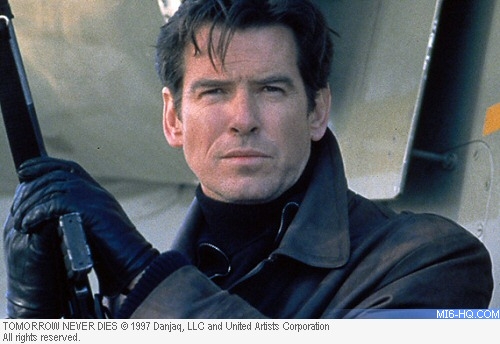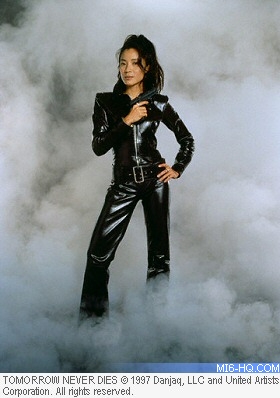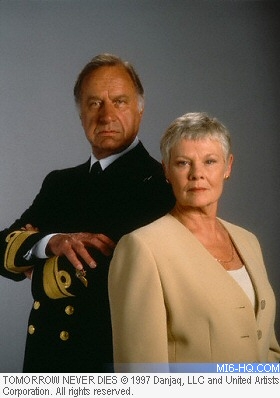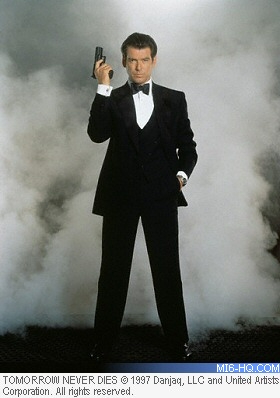Production Notes - Tomorrow Never
Dies
The 18th 'official' Bond film faced many challenges, not least
of which being that it was the first to be made since the death
of Albert
R. Broccoli, the producer who, with original partner
Harry Saltzman, had instigated the series back in 1962. It also
had to prove that the phenomenal global success of Goldeneye [1995]
was no fluke, that Bond really was back to stay.

Above: Pierce Brosnan as James
Bond.
|
The story that would eventually become Tomorrow
Never Dies has
its roots in a treatment that was written by novelist Donald Westlake
before Goldeneye was filmed. It's not clear exactly what role
the treatment played in the final production, but it certainly
seems to have had some influence over a script being prepared
by Goldeneye co-writer Bruce Feirstein which revolved around Britain's
then-imminent handing over of its colony in Hong Kong to the Chinese.
Goldeneye director Martin
Campbell, whose work on the film was
clearly a major factor in the film's success, was unwilling to
work on two consecutive films and it was left to executive producer
Michael
G. Wilson to track down a new director.
|
He found him in Roger
Spottiswoode, a British
ex-patriot who had edited for Sam Peckinpah in the early
70s [Straw Dogs [1971], The Getaway [1972], Pat Garrett
and Billy the Kid [1973]] before becoming a director with
the forgettable Terror Train [1980]. While in Hollywood,
Spottiswoode's career had encompassed such movies as Air
America [1990], Under Fire [1993] and the American TV film
And the Band Played On [1993].
When he signed on with EON, Spottiswoode set to work reworking
Feirstein's script, assembling seven scriptwriters at the
Athenaeum Hotel in an effort to get the screenplay, now
titled Tomorrow Never Lies, into some kind of shape. Among
these Hollywood luminaries, who came to the London brainstorming
session unpaid, were Robert Collector [writer of Memoirs
of an Invisible Man [1992] and Nightflyers [1987]] and
Nicolas Meyer [The Seven Per Cent Solution [1976], Time
After Time [1980], Star Trek II: The Wrath of Khan [1982]].
Over time, Daniel Petrie Jr [Beverly Hills Cop [1984],
Shoot To Kill [1988], Turner and Hooch [1989]] and David
Campbell Wilson were called in to work on the script before
Feirstein - who would retain sole writing credit - was
brought back to give the script a final polish.
|
|

Above: James Bond's new 'equal' was Wai Lin, played by
Hong Kong action movie star Michelle Yeoh.
|
With work on the script dragging [it wasn't completed until
a week before photography was due to begin], EON began the casting
process. Pierce Brosnan was onto the second film in his four
film contract and it was already difficult to imagine the series
without
him. Other returnees from Goldeneye were Desmond
Llewelyn [Q],
Judi Dench [M], Joe
Don Baker [Jack Wade] and Samantha
Bond [Moneypenny].
Ranged against Bond this time would be deranged media mogul Elliot
Carver. The part was originally offered to Anthony Hopkins, who
had also been approached for a part in Goldeneye. Hopkins was
reportedly interested in appearing in Tomorrow Never Dies but
eventually turned the part down. In February 1997, Wilson met
with Jonathan Pryce and he accepted the offer to play the power-crazy
Carver.
The Bond girls this time were a satisfying mix of the traditional
and the decidedly new - traditionalists included former Lois Lane
Teri Hatcher, who was hot off the success of the set of ABC's
recently retired Lois and Clark: The New Adventures of Superman
[1993 - 1997]. Hatcher, who was pregnant during the shoot, had
finished Lois and Clark's final episode on the Monday, arrived
in the UK on Tuesday and began shooting her scenes for Tomorrow
Never Dies on the Wednesday. The other traditionalist was rock
star Bryan Adams' then-girlfriend Cecilie
Thomsen as language professor
Inga Bergstrom.
|
Rather more interesting was Michelle
Yeoh, a former Miss
Malaysia who had gone on to carve out a distinguished career
in Hong Kong action movies. Making her debut in a western
film, Yeoh was cast as a sort of female Bond, "his
Chinese counterpart" Brosnan called her, who was to
more than hold her own against Bond. Yeoh was prevented
from doing a lot of her own stunts by the production's
insurance agents [which was certainly frustrating for the
actress - back home she was used to getting into the thick
of it], though the arrival of seven members of a Hong Kong
stunt team gave her the chance to show off her martial
arts skills to excellent effect.
Goldeneye had seen the Bond series leaving its traditional
home at Pinewood and setting up home at Leavesden, the
former Rolls Royce factory had been sold off to a Malaysian
company named Third Millenium. By the time Tomorrow Never
Dies was ready to start shooting, the newly renamed Millenium
Studios was home to George Lucas' Star Wars Episode I:
The Phantom Menace [1999] and only a meagre 400,000 square
feet was left available to EON
|
|

|
Clearly this wasn't going to be enough and EON again created
its own studios space, this time taking over a former grocery
distribution warehouse in Frogmore, St Albans which was converted
into the new EON Studios. The colossal 007 stage at Pinewood was
also used - the first time Bond had filmed there since The Living
Daylights [1987] - to house the interior of Carver's stealth ship.
Filming began on 18 January 1987 with the pre-credits sequence,
the French Pyrenees standing in for a mountain range in Afghanistan.
The second unit was this time under the supervision of Vic Armstrong,
a former stuntman whose association with Bond went back to You
Only Live Twice [1967] on which he was one of the many stuntmen.
The explosive opening sequence was in the can
by the end of February and the second unit moved on to Portsmouth
where night shooting
at the Royal Naval vessel HMS Westminster and the land establishment
HMS Dryad doubled for the scenes where Royal Navy vessels prepare
to engage the Chinese navy.
On Tuesday 1 April 1997, the main unit moved in to EON Studios
and began their work. But problems were not far away - the crew
was scheduled to travel to Ho Chi Min City and other destinations
in Vietnam on 1 May for location work, but the Vietnamese government
suddenly had a change of heart. The official line had it that
the newly emerging Vietnamese cinema industry wasn't equipped
to deal with a production on the scale of a Bond film. Unofficially,
it was suggested that although the Ministry of Culture had agreed
to co-operate with EON, Ho Chi Min City's People's Committee were
upset by the series' negative attitude towards Communism. The
Vietnamese Ministry of Culture would only say that the film had
been refused permission to shoot in Vietnam for "many complicated
reasons."
|
The Vietnamese excursion was cancelled and a suitable
alternative was being sought out during May while the main
unit touched down at RAF Lakenheath and the USAF base at
Mildenhall in Cambridgeshire. A couple of weeks later,
Brosnan and Hatcher were filming their love scene at the
Stoke Poges golf club, previously used as a location for
Goldfinger [1964].
The production next set off for Thailand which was now
going to be used for the South East Asia scenes instead
of Vietnam. It was here that Jean-Pierre Goy performed
the stunning motorcycle leap across a hovering helicopter
that would cap one of the film's best action sequences.
Several of the Thai locations were meticulously recreated
back at Frogmore by production designer Allan Cameron.
While in the East, the production once again called in
at the island of Khow-Ping-Khan. one of a string of islands
near Phuket, off the Malay peninsular. The island, now
unofficially renamed James Bond Island by the locals, had
been visited back in November 1974 by the cast and crew
of The Man With the Golden Gun [1974]. |
|

|
Brosnan was grateful to leave the unbearable heat of Thailand
behind him when he returned to the UK to join the second unit
at the rather less glamorous location of the Brent Cross Shopping
Centre in North West London. One of the centre's multi-storey
car parks was to stand in for the car park in Hamburg where Bond
was to use his gadget-laden, remote-controlled
BMW to evade a
gang of Carver's assassins. As the car park was rocked by a series
of explosions, one concerned member of the public - not realising
what was going on - called for the police and fire brigade!
On 17 July, Brosnan was injured during one of the fight scenes,
a stuntman's helmet hitting the star in the face. Brosnan required
eight stitches down one side of his face, leaving the crew no
choice but to film many of his scene from one profile only.
Production ended in September after detours to Mexico, Hamburg
and Florida, and by all accounts it wasn't the happiest of shoots
- although he towed the party line during filming, Brosnan later
described the experience of making Tomorrow Never Dies as "like
pulling teeth."
After the too-many-cooks approach to the soundtrack of Goldeneye,
the music department was considerably slimmed down for Tomorrow
Never Dies. In the place of the three composers and two song writers
that had worked on Goldeneye, EON handed the soundtrack duties
over to David
Arnold, an acclaimed producer who had previously
worked with the likes of Bjork. Arnold was to revamp the Bond
soundtracks, retaining many of the characteristics of the John
Barry soundtracks he so admired but bringing in new, dance influenced
elements.
In June, it was announced that the new song would be performed
by American rock singer Sheryl Crow who was enjoying great success
on both sides of the Atlantic at the time. To commemorate his
appointment to the Bond series, and the emphasis his desire to
mix the old with the new, Arnold released the album Shaken and
Stirred in October 1997, a collection of covers of Bond songs
performed by Pulp's Jarvis Cocker, Iggy Pop, Chrissie Hynde and
many others.
Throughout production, there was much concern that the film might
not be ready for its intended release date, prompting MGM/UA's
impressively titled Executive Vice President of International
Distribution Marketing Guy Laurence to issue a statement: "This
film will be ready, and anyone who says it won't is either wrong
or showing considerable bad faith."
MGM/UA themselves badly needed another hit Bond film. There
had been another reshuffle of the board and Variety had taken
to describing the company's financial situation as 'tender.'
Tomorrow Never Dies was MGM/UA's only Christmas 1997 release
and they'd sunk a reported $100 million into the film.
Their faith in the character was rewarded when Tomorrow Never
Dies became one of the most successful films in the series. Following
its London premiere on 10 December 1997, the film opened in the
States against James Cameron's mighty Titanic [1997] and even
managed to brush that aside - referring to MGM's famous trademark,
Rex Weiner in Variety quipped that "Bond must beat the boat
and save the lion." He did so admirably and proved that
Goldeneye had been no fluke. Bond was back and, it seemed, he
was here to
stay.